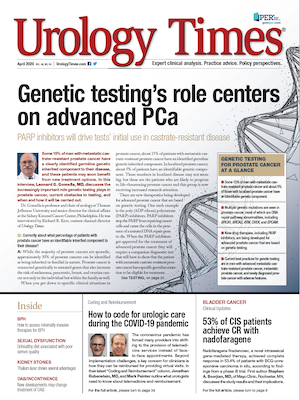Publication
Article
Urology Times Journal
Utilization review data: How do payers view your practice?
Author(s):
"Many companies understand your utilization, payment, and prescribing data much more thoroughly than you might think," writes Robert A. Dowling, MD.

The shift from fee for service to value-based care and reimbursement may be happening faster than some physicians like and slower than most payers would like. While urologic care is estimated to comprise only 2% of the “health care spend” in the U.S., it may not logically follow that urologists will delay or escape the consequences of oversight, scrutiny, and policies of government and commercial payers.
The increased burden of preauthorization faced by many physician practices is but one sign that payers are watching the dollars closely. Another trend is the availability of your practice and physician data in the public domain. In this article, I will review the concept of “utilization review” in the modern context and describe how you can gain insights into how payers and other stakeholders view your own practice.
Defining utilization review
Utilization review in health care dates to the 1970s and was defined by Merriam-Webster then as “a critical evaluation of health care services provided to patients that is made especially for the purpose of controlling costs and monitoring quality of care.” The term evokes an image of a nurse, or an entire department, in a hospital poring over individual charts in the pursuit of reducing the cost of care in the hospital. Others may think of utilization review as a mechanism used by payers to systematically delay or deny care.
In the modern context, utilization review is more likely to be conducted by examining large data sets looking for service patterns, outliers, or comparisons to a benchmark that can help lead to better “value.”
One example familiar to many urologists is the American Board of Urology’s collection of practice logs from diplomates during the maintenance of certification process. According to the ABU’s website (www.abu.org/lifelong-learning), “the practice logs allow the trustees to be certain that the Diplomate has a sufficient case load to maintain their skills. Most importantly we have the opportunity to provide feedback to the Diplomate.”
Another example is the publication of utilization and payment data by physician in the Medicare program (bit.ly/cmsutilizationdata). Medicare also publishes Part D prescriber data for individual physicians (bit.ly/partdprescriberdata), and drug utilization and cost data. Commercial private payers have their own physician utilization data, though they do not usually publish it. Other companies collect pharmacy dispensing data, claims submission and remittance data, pharmaceutical sales data, and more-at the physician level. Many companies understand your utilization, payment, and prescribing data much more thoroughly than you might think.
How can you begin to understand your practice-as it is reflected in how much you “cost” those paying for the care-as well as these outside entities? The process begins with access to your claims data-something that almost all practice management systems allow in the application, with an inexpensive reporting module, by employing a third party with very basic database skills, or by using a commercial platform.
The next step that can be very helpful and save time is determining what question you would like to answer. For example, the data extracted for a review of procedures for stone surgery might be completely different than that needed for a comparison of physician in-office administration of injectable medications. By thinking through the purpose of your review and how you would act upon the results of that review, you can streamline the analysis, find your answers faster, and put that knowledge to work.
A common challenge in understanding utilization of health care services is comparing apples to apples. Building on the example of utilization of stone surgery, raw claims data are likely to show some physicians perform more surgery than others-perhaps by an order of magnitude (10 times) in a large practice. This information by itself is of limited use and needs to be calibrated to some reference common to the physicians being compared.
For example, the rate of stone surgery per unique patient with a diagnosis of a ureteral or renal stone might provide the necessary indexing to make a better comparison. The Quality Payment Program levels its comparisons of episode costs using risk adjustment. Commercial payers often index their utilization metrics simply to number of beneficiaries, and you can do the same.
Establish a benchmark
Another challenge in using utilization data is finding a definition of average, normal range, or outlier for comparison-a benchmark. Benchmarking in health care can be internal to an organization (such as comparing physicians in one practice) or external to an organization (such as comparing your urology practice to hundreds of others across the country). Statistical methods used in benchmarking include comparisons to mean, median (the midpoint of data or 50th percentile), rank, or decile. Medicare’s Quality Payment Program uses deciles in the Quality, Cost, and Promoting Interoperability categories to determine relative performance.
The median or 50th percentile is often a better point of comparison than the mean in health care data, which may not always follow a “normal” distribution. Available sources for external benchmarking of claims data include Medical Group Management Association survey data (www.mgma.com/data), Medicare public use files mentioned earlier, the Quality Payment Program (limited at this point), and commercial platforms.
Perhaps the biggest challenge is once you understand your utilization data, you will need to decide what to do about it. Some decisions may be easy; if you have a large practice and a single outlier, your data and internal benchmarking may convince the outlier physician to examine and change their practice. Other decisions may be more difficult and require an external credible benchmark to support a crucial conversation. The larger that benchmark, the more closely you can understand the perspective of a large payer. The underlying premise for understanding and acting on your utilization data is the knowledge that this information is available, and being used, by the sources of revenue for your practice.
Bottom line: Your utilization data are widely available and understood by the federal government, commercial payers, and commercial data aggregators. Improving your literacy with your own data will position your practice to better face the challenges of value-based care and reimbursement.

Newsletter
Stay current with the latest urology news and practice-changing insights — sign up now for the essential updates every urologist needs.
























